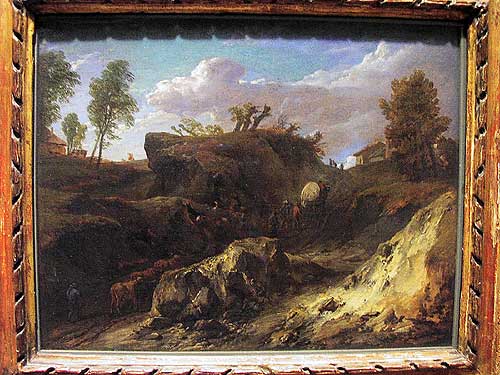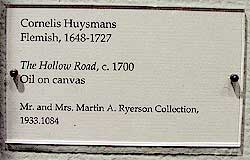Whatever Strikes my Fancy.
 |
 |
Cornelius Huysmans is an ancestor on my maternal grandmother's quarter of the family (her maiden name was Huysmans and one of her middle names was Cornelia). Here's what the 1911 edition of the Encyclopedia Britannica has to say about him:
HUYSMANS, the name of four Flemish painters who matriculated in the Antwerp gild in the 17th century. Cornelis the elder, apprenticed in 1633, passed for a mastership in 1636, and remained obscure. Jacob, apprenticed to Frans Wouters in 1650, wandered to England towards the close of the reign of Charles II., and competed with Lely as a fashionable portrait painter. He executed a portrait of the queen, Catherine of Braganza, now in the national portrait gallery, and Horace Walpole assigns to him the likeness of Lady Bellasys, catalogued at Hampton Court as a work of Lely. His portrait of Izaak Walton in the National Gallery shows a disposition to imitate the styles of Rubens and Van Dyke. According to most accounts he died in London in 1696. Jan Baptist Huysmans, born at Antwerp in 1654, matriculated in 1676-1677, and died there in 1715-1716. He was younger brother to Cornelis Huysmans the second, who was born at Antwerp in 1648, and educated by Gaspar de Wit and Jacob van Artois. Of Jan Baptist little or nothing has been preserved, except that he registered numerous apprentices at Antwerp, and painted a landscape dated 1697 now in the Brussels museum. Cornelis the second is the only master of the name of Huysmans whose talent was largely acknowledged. He received lessons from two artists, one of whom was familiar with the Roman art of the Poussins, whilst the other inherited the scenic style of the school of Rubens. He combined the two in a rich, highly coloured, and usually effective style, which, however, was not free from monotony.Seldom attempting anything but woodside views with fancy backgrounds, half Italian, half Flemish, he painted with great facility, and left numerous examples behind. At the outset of his career he practised at Malines, where he married in 1682, and there, too he entered into some business connection with van der Meulen, for whom he painted some backgrounds. In 1706 he withdrew to Antwerp, where he resided till 1717, returning then to Malines, where he died on the 1st of June 1727.
Though most of his pictures were composed for cabinets rather than churches, he sometimes emulated van Artois in the production of large sacred pieces, and for many years his Christ on the Road to Emmaus adorned the choir of Notre Dame of Malines. In the gallery of Nantes, where three of his small landscapes are preserved, there hangs an Investment of Ltixembourg, by van der Meulen, of which he is known to have laid in the background. The national galleries of London and Edinburgh contain each one example of his skill. Blenheim, too, and other private galleries in England, possess one or more of his pictures. But most of his works are on the European continent.
I didn't know the Art Institute of Chicago has any of his work. I know the Metropolitan in New York does, but we forgot to look for it when we were there. Obviously, not knowing that it was even there, I wasn't looking for this as we wandered through the AIC. It's a smaller piece (about 8" x 10" or so) and was hanging unceremoniously in a hallway connecting the galleries in the European section of the museum. The name caught me out of the corner of my eye and I exclaimed, "Holy shit!" rather loudly. My uncouth exclamation got the attention of a guard who then stood by confusedly watching me excitedly snap pictures of a small, minor piece by a largely unknown artist hanging in a connecting hallway in a backwater of the museum.
Oringinal post: http://mbarrick.livejournal.com/505178.html